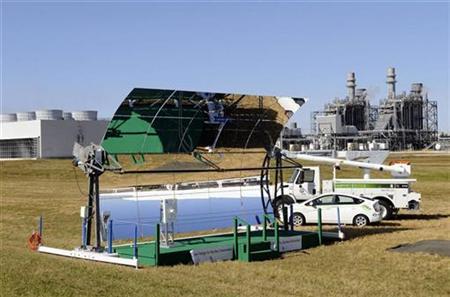Date: 19-Jan-09
Country: US
Author: Eileen O'Grady
Southern States Pick Up Pace On Renewable Power Photo: Florida Power and Light Company/Doug Murray/Handout
FPL's Hybrid bucket truck and electric plug-in car are shown at the ground breaking ceremony for FPL's Martin Next Generation Solar Energy Center in Indiantown, Florida December 2, 2008.

Photo:
Florida Power and Light Company/Doug Murray/Handout
HOUSTON - Southern U.S. states are picking up the pace to force electric
utilities to diversify fuel resources to include wind, solar, biomass and
other renewable power resources, according to regulators.
Over the past week, regulators in Florida and Louisiana took action that may
set utilities on a course to use cleaner energy sources that generate fewer
heat-trapping greenhouse gases -- a so-called renewable portfolio standard (RPS).
In Texas -- already the nation's leading wind-production state --
legislators this year may consider increasing the state's renewable mandate
or requiring more solar power and non-wind alternatives. The state surpassed
its current renewable target of 5,000 MW last year.
So far, efforts by U.S. lawmakers to create a nationwide renewable portfolio
standard have been rebuffed by lawmakers in southern states like Georgia,
which lacks wind and solar opportunities seen in other states.
A national renewable target could get a boost in coming months.
President-elect Barack Obama wants to require utilities to get 25 percent of
their electricity from renewable sources by 2025.
If Florida lawmakers ratify recommendations from the Florida Public Service
Commission, investor-owned utilities FPL Group, Progress Energy Florida and
Tampa Electric would be required to meet 20 percent of their energy needs
through renewable resources by 2020.
In 2007, Florida got just 3.6 percent of its electricity from renewable
sources.
"Florida's continued commitment to new renewable energy projects is
strengthened through the draft rule, which further diversifies our energy
mix and increases our energy security and stability," said Matthew M. Carter
II, PSC chairman.
In Louisiana, state regulators moved to revisit a renewable energy pilot
program launched several years ago, said PSC member Lambert Boissiere. Any
renewable measure could have an impact on Entergy Corp, the state's biggest
utility, and Cleco Corp.
"It is time because the technology is growing by leaps and bounds in this
area and it is becoming more imperative that we make decisions to lead the
industry," said Boissiere.
Florida's 20 percent by 2020 draft rule was more ambitious than a slower
timeline suggested by the agency staff. That proposal called for a renewable
mandate of 5 percent by 2017, rising gradually to 20 percent by 2041.
Florida Gov. Charlie Crist is leading a broad effort in the state to address
climate change issues.
Florida's proposal is heavily weighted toward solar and wind power,
requiring that one-quarter of the renewable supply come from solar and wind.
While utility spending was capped at 2 percent of retail revenue,
three-fourths of that budget will go toward solar and wind rather than
biomass or other forms of renewable energy.
Utility performance under the RPS standard will be reviewed every three
years and companies will be penalized for noncompliance, a PSC spokeswoman
said.
(Editing by Jim Marshall)
© Thomson Reuters 2009 All rights reserved
